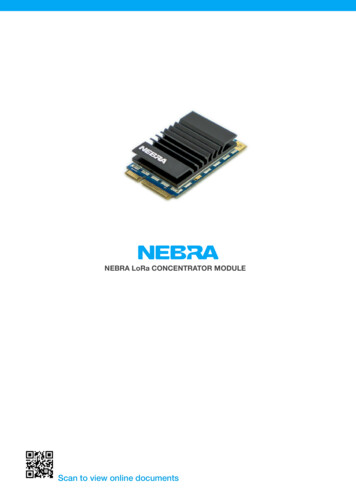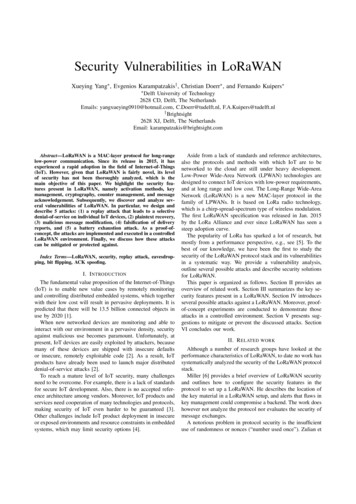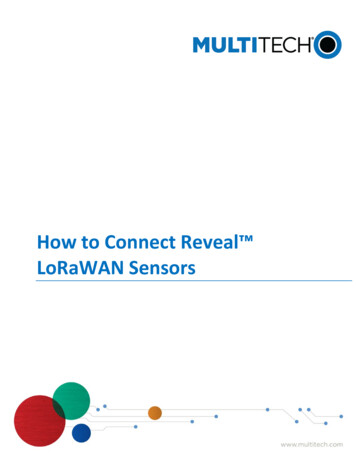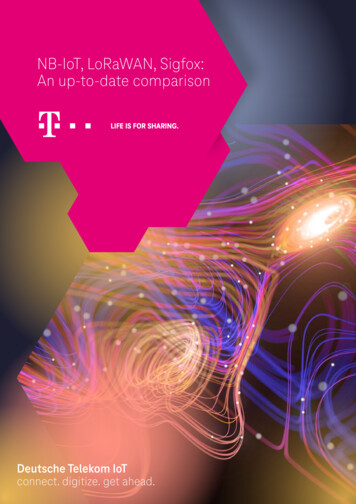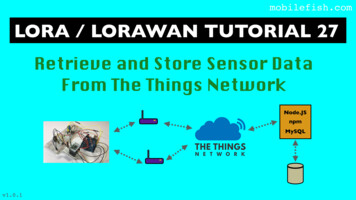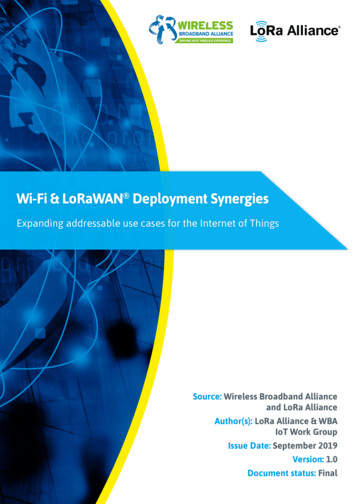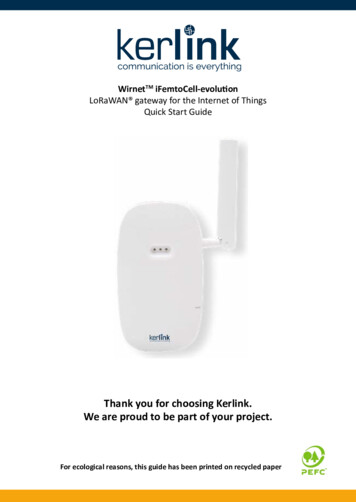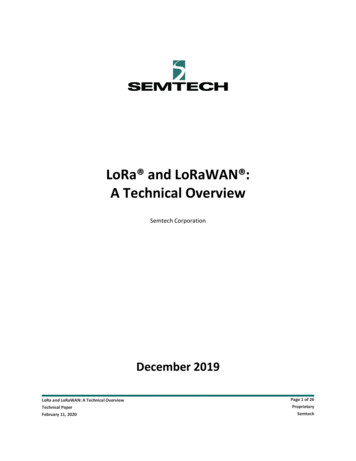
Transcription
LoRa and LoRaWAN :A Technical OverviewSemtech CorporationDecember 2019LoRa and LoRaWAN: A Technical OverviewTechnical PaperFebruary 11, 2020Page 1 of 26ProprietarySemtech
What are LoRa and LoRaWAN ?LoRa is an RF modulation technology for low-power, wide area networks (LPWANs). The name, LoRa, is areference to the extremely long-range data links that this technology enables. Created by Semtech tostandardize LPWANs, LoRa provides for long-range communications: up to three miles (five kilometers)in urban areas, and up to 10 miles (15 kilometers) or more in rural areas (line of sight). A keycharacteristic of the LoRa-based solutions is ultra-low power requirements, which allows for thecreation of battery-operated devices that can last for up to 10 years. Deployed in a star topology, anetwork based on the open LoRaWAN protocol is perfect for applications that require long-range ordeep in-building communication among a large number of devices that have low power requirementsand that collect small amounts of data.Consider the differences between LoRa and other network technologies that are typically used in IoT ortraditional machine-to-machine (M2M) connectivity solutions:Figure 1: IoT TechnologiesNote: In Europe, mobile network operators have implemented a dual strategy to address packet sizeand latency issues. They often offer both LoRaWAN and Cat-M1, which are complementarytechnologies. LoRaWAN accommodates the need for longer battery life, with a trade-off of longerlatency and smaller packet sizes. In contrast Cat-M1 can be used for larger payloads with less latencythan LoRaWAN can accommodate.Page 2 of 26LoRa and LoRaWAN: A Technical OverviewProprietaryTechnical PaperDecember 2019semtech.com/LoRaSemtech
Figure 2 highlights some important advantages of deploying a LoRaWAN network:Figure 2: Advantages of deploying a LoRaWAN networkLet’s look into these advantages in a little more depth.With respect to range, a single LoRa-based gateway can receive and transmit signals over a distance ofmore than 10 miles (15 kilometers) in rural areas. Even in dense urban environments, messages are ableto travel up to three miles (five kilometers), depending on how deep indoors the end devices (endnodes) are located.As far as battery life goes, the energy required to transmit a data packet is quite minimal given that thedata packets are very small and only transmitted a few times a day. Furthermore, when the end devicesare asleep, the power consumption is measured in milliwatts (mW), allowing a device’s battery to lastfor many, many years.Page 3 of 26LoRa and LoRaWAN: A Technical OverviewProprietaryTechnical PaperDecember 2019semtech.com/LoRaSemtech
When it comes to capacity, a LoRaWAN network can support millions of messages. However, the numberof messages supported in any given deployment depends upon the number of gateways that are installed.A single eight-channel gateway can support up to 1.5M messages over the course of a 24-hourperiod. If each end device sends a message every hour, such a gateway can support up to 60,000devices1. If the network includes 10 such gateways, the network can support roughly 100,000 devicesand one million messages. If more capacity is required, all that is needed is to add additional gateways tothe network.And then, there is cost. Given the capabilities of LoRa-based end nodes and gateways, only a fewgateways – configured in a star network – are required to serve a multitude of end nodes. This meansthat capital and operational expenses can be kept relatively low. Also, when the cost-effective LoRa RFmodules that are embedded in inexpensive end nodes are used in conjunction with the open LoRaWANstandard, the return on investment can be considerable.Radio Modulation and LoRaA proprietary spread-spectrum modulation technique derived from existing Chirp Spread Spectrum (CSS)technology, LoRa offers a trade-off between sensitivity and data rate, while operating in a fixedbandwidth channel of either 125 KHz or 500 KHz (for uplink channels), and 500 KHz (for downlinkchannels). Additionally, LoRa uses orthogonal spreading factors. This allows the network to preserve thebattery life of connected end nodes by making adaptive optimizations of an individual end node’s powerlevels and data rates. For example, an end device located close to a gateway should transmit data at alow spreading factor, since very little link budget is needed. However, an end device located severalmiles from a gateway will need to transmit with a much higher spreading factor. This higher spreadingfactor provides increased processing gain, and higher reception sensitivity, although the data rate will,necessarily, be lower.LoRa is purely a physical (PHY), or “bits” layer implementation, as defined by the OSI seven-layerNetwork Model, depicted in Figure 3. Instead of cabling, the air is used as a medium for transportingLoRa radio waves from an RF transmitter in an IoT device to an RF receiver in a gateway, and vice versa.Page 4 of 26LoRa and LoRaWAN: A Technical OverviewProprietaryTechnical PaperDecember 2019semtech.com/LoRaSemtech
Figure 3: OSI seven-layer network modelIn a traditional or Direct Sequence Spread Spectrum (DSSS) system, the carrier phase of the transmittersignal changes according to a code sequence as shown in Figure 4. When multiplying the data signal witha pre-defined bit pattern at a much higher rate, also known as a spreading code (or chip sequence), a“faster” signal is created that has higher frequency components than the original data signal. This meansthat the signal bandwidth is spread beyond the bandwidth of the original signal. In RF terminology, thebits of the code sequence are called chips (in order to distinguish between the longer, un-coded, bits ofthe original data signal). When the transmitted signal arrives at the RF receiver, it is multiplied with anidentical copy of the spreading code used in the RF transmitter, resulting in a replica of the original datasignal.Page 5 of 26LoRa and LoRaWAN: A Technical OverviewProprietaryTechnical PaperDecember 2019semtech.com/LoRaSemtech
Figure 4: DSSS system carrier phase transmitter signal changesYou might ask: Why go through all this trouble? Why not just transmit the original data signal instead ofgoing through this code sequence multiplication? The answer is simple: going through this codesequence multiplication buys you a higher RF link budget, so you can transmit over a longer range.The Log10 ratio of the code sequence’s chip rate and the data signal’s bit rate is called the processinggain (Gp). This gain is what allows the receiver to recover the original data signal, even if the channel hasa negative signal-to-noise ratio (SNR). LoRa has a superior Gp compared to frequency-shift keying (FSK)modulation, allowing for a reduced transmitter output power level while maintaining the same signaldata rate and a similar link budget.One of the downsides of a DSSS system is the fact that it requires a highly-accurate (and expensive)reference clock. Semtech’s LoRa Chirp Spread Spectrum (CSS) technology offers a low-cost and low-Page 6 of 26LoRa and LoRaWAN: A Technical OverviewProprietaryTechnical PaperDecember 2019semtech.com/LoRaSemtech
power, yet robust, DSSS alternative that does notrequire a highly-accurate reference clock. In LoRamodulation, the spreading of the signal’s spectrum isachieved by generating a chirp signal thatcontinuously varies in frequency, as is depicted inFigure 5.An advantage of this method is that the timing andfrequency offsets between transmitter and receiverare equivalent, greatly reducing the complexity of thereceiver design. The frequency bandwidth of thischirp is equivalent to the spectral bandwidth of the signal. Figure 5: LoRa Chirp Spread Spectrum illustrationThe data signal that carries the data from an end deviceto a gateway is chipped at a higher data rate and modulated onto the chirp carrier signal. LoRamodulation also includes a variable error correction scheme that improves the robustness of thetransmitted signal. For every four bits of information sent, a fifth bit of parity information is sent.Key LoRa Modulation PropertiesAs noted above, LoRa processing gain is introduced in the RF channel by multiplying the data signal witha spreading code or chip sequence. By increasing the chip rate, we increase the frequency componentsof the total signal spectrum. In other words, the energy of the total signal is now spread over a widerrange of frequencies, allowing the receiver to discern a signal with a lower (that is, worse) signal-tonoise ratio (SNR).In LoRa terms, the amount of spreading code applied to the original data signal is called the spreadingfactor (SF). LoRa modulation has a total of six spreading factors (SF7 to SF12). The larger the spreadingfactor used, the farther the signal will be able to travel and still be received without errors by the RFreceiver.Table 1 shows the four different spreading factors [SF7 SF10] that can be used for uplink (UL) messageson a 125 KHz channel1. It shows the equivalent bit rate as well as the estimated range (this depends onthe terrain; longer distances will be achieved in a rural environment thank in an urban environment). Italso shows the dwell time, or time on air (TOA), values for an 11-byte payload for each of the fourspreading factors.1 Downlink messages broadcast over 500 KHz channels can use all six available spreading factors (SF7 SF12).Page 7 of 26LoRa and LoRaWAN: A Technical OverviewProprietaryTechnical PaperDecember 2019semtech.com/LoRaSemtech
Table 1: LoRa Spreading FactorsImportantly, the LoRa modulation spreading factors are inherently orthogonal. This means that signalsmodulated with different spreading factors and transmitted on the same frequency channel at the sametime do not interfere with each other. Instead, signals at different spreading factors simply appear to benoise to each other.LoRa signals are robust and very resistant to both in-band and out-of-band interference mechanisms.LoRa modulation also offers immunity to multipath and fading, making it ideal for use in urban andsuburban environments, where both mechanisms dominate. Additionally, Doppler shifts cause a smallfrequency shift in the time axis of the baseband signal. This frequency offset tolerance mitigates therequirement for tight tolerance reference clock sources and, therefore, makes LoRa ideal for datacommunications from devices that are mobile.LoRa Modulation CharacteristicsThe LoRa modulation characteristics for each region are defined in the LoRaWAN Regional Parametersdocument, available from the LoRa Alliance orawanr-regional-parameters). In North America, there are 64, 125 kHz LoRa uplink channels defined,centered on a 200 kHz raster as can be seen in Figure 5. 11. There are eight 500 kHz uplink channels aswell as eight, 500 kHz downlink channels defined. In North America, gateways can have up to 64, 125kHz uplink channels as well as eight 500 kHz uplink and downlink channels. This type of gateway isreferred to as a carrier grade macro gateway and is used for outdoor applications only.Page 8 of 26LoRa and LoRaWAN: A Technical OverviewProprietaryTechnical PaperDecember 2019semtech.com/LoRaSemtech
Figure 6: LoRa modulation characteristicsTable 2 provides another way to understand these modulation characteristics.Table 2: LoRa modulation characteristicsData Rate(DR)SpreadingFactor (SF)ChannelFrequencyUplink orDownlinkBitrate(Bits/Sec)Maximum UserPayload Size (Bytes)0SF10125 kHzUplink980111SF9125 kHzUplink1,760532SF8125 kHzUplink3,1251253SF7125 kHzUplink5,4702424SF8500 kHzUplink12,5002428SF12500 kHzDownlink980539SF11500 kHzDownlink1,76012910SF10500 kHzDownlink3,12524211SF9500 kHzDownlink5,47024212SF8500 kHzDownlink12,50024213SF8500 kHzDownlink21,9002425–7Page 9 of 26LoRa and LoRaWAN: A Technical OverviewProprietaryTechnical PaperDecember 2019semtech.com/LoRaSemtech
The LoRa physical layer is intended for low throughput, low data rate, and high link budget (i.e.,“long-range”) applications.For a fixed channel bandwidth, the higher the spreading factor, the higher the processing gain,resulting in an increase in sensitivity and, therefore, an increase in link budget. Subsequently,however, the time on air will also increase.Orthogonality between spreading factors allows for the transmission of multiple LoRa signalsthat are both on the same channel frequency and in the same time-slot.For a fixed SF, a narrower bandwidth will increase sensitivity as the bit rate is reduced.LoRaWAN in North America uses 125 kHz uplink channels and 500 kHz uplink and downlinkchannelsThe Code Rate is the degree of redundancy implemented by the forward error correction (FEC)used to detect errors and correct them. This rate is fixed at 4/5 for the LoRaWAN protocolAs Stephan Hengstler asserts in his book, A Novel Chirp Modulation Spread Spectrum technique forMultiple Access, “LoRa is a constant envelope modulation (very low cost, power efficient poweramplifier implementation) [it] is the most robust, ultra-low power and long range RF solutionavailable.”Data Collisions and Spreading Factor OrthogonalityWith LoRa, packets using different spreading factors are orthogonal, meaning that they are invisible toeach other: as mentioned earlier, they simply appear as noise to one another. Therefore, two packetsthat arrive at the same time on the same receive channel at different spreading factors will not collideand, both will be demodulated by the gateway modem chip. However, two packets with the samespreading factor arriving at the same time on the same channel might result in a collision. However ifone of the two packets is stronger by six dB, it will survive.The capacity of a LoRaWAN network is a function of its gateway density. To maximize the capacity of thenetwork, using an adaptive data rate (ADR) mechanism is essential. The main goal of ADR is to save thebattery power of the LoRaWAN end-nodes. By having the end-nodes closest to a gateway transmit usingthe lowest spreading factor, their time on air is minimized, thereby prolonging their battery life. Moredistant sensors transmit at a higher spreading factor. A trade-off is made between battery power anddistance given that a higher spreading factor allows for a gateway to connect to devices that are fartheraway.LoRaWAN Network FundamentalsTo fully understand LoRaWAN networks, we will start with a look at the technology stack. As shown inFigure 7, LoRa is the physical (PHY) layer, i.e., the wireless modulation used to create the long-rangecommunication link. LoRaWAN is an open networking protocol that delivers secure bi-directionalcommunication, mobility, and localization services standardized and maintained by the LoRa Alliance.Page 10 of 26LoRa and LoRaWAN: A Technical OverviewProprietaryTechnical PaperDecember 2019semtech.com/LoRaSemtech
Figure 7: LoRaWAN technology stackLoRaWAN Network Elements: An IntroductionNow that we have a basic understanding of LoRa, we will examine the architecture of a LoRaWAN network.Figure 8 shows a typical LoRaWAN network implementation from end to end.Figure 8: Typial LoRaWAN network implementationLet us examine this diagram in smaller pieces.Page 11 of 26LoRa and LoRaWAN: A Technical OverviewProprietaryTechnical PaperDecember 2019semtech.com/LoRaSemtech
LoRa-based End DevicesFigure 9: End devices in a typical LoRaWAN network deploymentA LoRaWAN-enabled end device is a sensor or an actuator which is wirelessly connected to a LoRaWANnetwork through radio gateways using LoRa RF Modulation.In the majority of applications, an end device is an autonomous, often battery-operated sensor thatdigitizes physical conditions and environmental events. Typical use cases for an actuator include: streetlighting, wireless locks, water valve shut off, leak prevention, among others.When they are being manufactured, LoRa-based devices are assigned several unique identifiers. Theseidentifiers are used to securely activate and administer the device, to ensure the safe transport ofpackets over a private or public network and to deliver encrypted data to the Cloud.LoRaWAN GatewaysFigure 10: Gatewasy in a typical LoRaWAN network deploymentA LoRaWAN gateway receives LoRa modulated RF messages from any end device in hearing distanceand forwards these data messages to the LoRaWAN network server (LNS), which is connected throughPage 12 of 26LoRa and LoRaWAN: A Technical OverviewProprietaryTechnical PaperDecember 2019semtech.com/LoRaSemtech
an IP backbone. There is no fixed association between an end device and a specific gateway. Instead, thesame sensor can be served by multiple gateways in the area. With LoRaWAN, each uplink packet sent bythe end-device will be received by all gateways within reach, as illustrated in Figure 10. Thisarrangement significantly reduces packet error rate (since the chances that at least one gateway willreceive the message are very high), significantly reduces battery overhead for mobile/nomadic sensors,and allows for low-cost geolocation (assuming the gateways in question are geolocation-capable).The IP traffic from a gateway to the network server can be backhauled via Wi-Fi, hardwired Ethernet orvia a Cellular connection. LoRaWAN gateways operate entirely at the physical layer and, in essence, arenothing but LoRa radio message forwarders. They only check the data integrity of each incoming LoRaRF message. If the integrity is not intact, that is, if the CRC is incorrect, the message will be dropped. Ifcorrect the gateway will forward it to the LNS, together with some metadata that includes the receiveRSSI level of the message as well as an optional timestamp. For LoRaWAN downlinks, a gatewayexecutes transmission requests coming from the LNS without any interpretation of the payload. Sincemultiple gateways can receive the same LoRa RF message from a single end device, the LNS performsdata de-duplication and deletes all copies. Based on the RSSI levels of the identical messages, thenetwork server typically selects the gateway that received the message with the best RSSI whentransmitting a downlink message because that gateway is the one closest to the end device in question.Figure 11: Gateways receiving and transmitting messages from end devicesFurthermore, LoRa allows for scalable, cost-optimized gateway implementation, depending ondeployment objectives. For example, in North America, 8-, 16-, and 64-channel gateways are available.Page 13 of 26LoRa and LoRaWAN: A Technical OverviewProprietaryTechnical PaperDecember 2019semtech.com/LoRaSemtech
The 8-channel gateways are the least expensive. The type of gateway needed will depend on the usecase. Eight- and 16-channel gateways are available for both indoor and outdoor use. Sixty-four channelgateways are only available in a carrier-grade variant. This type of gateway is intended for deploymentin such places as cell towers, the rooftops of very tall buildings, etc.Network ServerFigure 12: LoRaWAN Network Server in a typical LoRaWAN network deploymentThe LoRaWAN network server (LNS) manages the entire network, dynamically controls the networkparameters to adapt the system to ever-changing conditions, and establishes secure 128-bit AESconnections for the transport of both the end to end data (from LoRaWAN end device to the end usersApplication in the Cloud) as well as for the control of traffic that flows from the LoRaWAN end device tothe LNS (and back). The network server ensures the authenticity of every sensor on the network and theintegrity of every message. At the same time, the network server cannot see or access the applicationdata.In general, all LoRaWAN network servers share the following features: Device address checkingFrame authentication and frame counter managementAcknowledgements of received messagesAdapting data rates using the ADR protocolResponding to all MAC layer requests coming from the device,Forwarding uplink application payloads to the appropriate application serversQueuing of downlink payloads coming from any Application Server to any device connected tothe networkForwarding Join-request and Join-accept messages between the devices and the join serverPage 14 of 26LoRa and LoRaWAN: A Technical OverviewProprietaryTechnical PaperDecember 2019semtech.com/LoRaSemtech
Application ServersApplication servers are responsible for securely handling, managing and interpreting sensor applicationdata. They also generate all the application-layer downlink payloads to the connected end devices.Figure 13: LoRaWAN Application Server in a typical LoRaWAN network deploymentJoin ServerThe join server manages the over-the-air activation process for end devices to be added to the network.The join server contains the information required to process uplink join-request frames and generate thedownlink join-accept frames. It signals to the network server which application server should beconnected to the end-device, and performs the network and application session encryption keyderivations. It communicates the Network Session Key of the device to the network server, and theApplication Session Key to the corresponding application serverPage 15 of 26LoRa and LoRaWAN: A Technical OverviewProprietaryTechnical PaperDecember 2019semtech.com/LoRaSemtech
Figure 14: LoRaWAN Join Server in a typical LoRaWAN network deploymentFor that purpose, the join server must contain the following information for each end-device under itscontrol: DevEUI (end-device serial unique identifier)AppKey (application encryption key)NwkKey (network encryption key)Application Server identifierEnd-Device Service ProfileLoRaWAN Network Elements: Device CommissioningFor the sake of security, quality of service, billing, and other needs, devices must be commissioned andactivated on the network at the start of operation. The commissioning process securely aligns eachdevice and the network with respect to essential provisioning parameters (such as identifiers,encryption keys, and server locations)The LoRaWAN specification allows for two types of activation: Over-the-Air Activation (OTAA)(preferred) and Activation by Personalization (ABP). Table 2 shows the different characteristics of eachof these types of activation.Table 3: Activation Types Over-the-Air Activation (OTAA)Device manufacturers autonomouslygenerate essential provisioningparametersSecure keys (session-long and derived)can be renewed regularlyDevices can store multiple “identities” todynamically and securely switchActivation by Personalization (ABP)A simplified (less secure) commissioningprocess IDs and Keys are personalized atfabrication Devices become immediately functionalupon powering up; the Join procedure isskipped Page 16 of 26LoRa and LoRaWAN: A Technical OverviewProprietaryTechnical PaperDecember 2019semtech.com/LoRaSemtech
networks and operators during itslifetimeHigh-grade, tamper-proof securityoptions are availableDevices are tied to a specificnetwork/service; the NetID is a portion ofthe device network addressLoRaWAN Network Elements: SecurityThere are two key elements to the security of a LoRaWAN network: the join procedure and messageauthentication. The join procedure establishes mutual authentication between an end device and theLoRaWAN network to which it is connected. Only authorized devices are allowed to join the network.LoRaWAN MAC and application messages are origin-authenticated, integrity-protected and encryptedend-to-end (i.e., from end device to the application server and vice versa).These security features ensure that: Network traffic has not been alteredOnly legitimate devices are connected to the LoRaWAN networkNetwork traffic cannot be listened to (no eavesdropping)Network traffic cannot be captured and replayedWith that foundation, we will take a look at the LoRaWAN security measures in more detail.The Join ProcedureWe will begin with the security keys, as illustrated in Figure 15. Individual root keys are securely storedon the end devices, and matching keys are securely stored on the join server.Figure 15: Security keys generated during the Join procedureThe end device sends a join request message to the join server, as illustrated in Figure 16.Page 17 of 26LoRa and LoRaWAN: A Technical OverviewProprietaryTechnical PaperDecember 2019semtech.com/LoRaSemtech
Figure 16: Sending a join request message to the join serverAfter the join server authenticates the device requesting to join the network, it returns a join acceptmessage to the device, as illustrated in Figure 17.Figure 17: Sending a join accept message to an end deviceNext, the end device derives session keys locally, based on the DevEUI, Join EUI, DevNonce, root keysand fields in the join request and join accept messages. On its end, the join server also derives sessionkeys from the serial IDs, root keys and fields in join requests and join accept messages. Finally, the joinserver shares session keys with network and application servers, as illustrated in Figure 18.Page 18 of 26LoRa and LoRaWAN: A Technical OverviewProprietaryTechnical PaperDecember 2019semtech.com/LoRaSemtech
Figure 18: Session keys are shared with the network server and the application serverFigure 19 illustrates the security of data packet transmissions. The control traffic between the enddevice and the network server is secured with a 128-bit AES Network Session Key (NwkSKey). The datatraffic that travels between the end device and the application server, is secured with a 128-bitApplication Session Key (AppSKey). This method ensures that neither the gateway nor the networkserver can read the user data.Figure 19: Secure transmission of data packetsDevice Classes: A, B and CLoRa-based end devices may operate in one of three modes, depending on their device class. All suchdevices must support Class A operation. Class B devices must support both Class A and Class B modes,Page 19 of 26LoRa and LoRaWAN: A Technical OverviewProprietaryTechnical PaperDecember 2019semtech.com/LoRaSemtech
and Class C devices must support all three modes of operation. These modes of operation have to dowith how the devices communicate with the network.Class A DevicesFigure 20 shows how the Class A mode of operation works.Figure 20: Class A operationIn this case, the end device spends most of its time in an idle state, (that is, in sleep mode). When thereis a change in the environment related to whatever the device is programmed to monitor, it wakes upand initiates an uplink, transmitting the data about the changed state back to the network (Tx). Thedevice then listens for a response from the network, typically for one second (although this duration isconfigurable). If it does not receive a downlink during this receive window (Rx1), it briefly goes back tosleep, waking a moment later, again listening for a response (Rx2). If no response is received during thissecond Rx window, the device goes back to sleep until the next time it has data to report. The delaybetween Rx1 and Rx2 is configured in terms of a delay from the end of the uplink transmission.Note: There is no way the application of the end device can wake up a Class A device. Given thislimitation, Class A devices are not suitable for actuators.Figures 21, 22 and 23 illustrate these communication patterns.Page 20 of 26LoRa and LoRaWAN: A Technical OverviewProprietaryTechnical PaperDecember 2019semtech.com/LoRaSemtech
Figure 21: Class A operation when nothing is receivedFigure 22: Class A operation when a data packet is received in the first receive windowFigure 23: Class A operation when a data packet is received in the second receive windowNote: A device will not try to send another uplink message until either:1. It has received a downlink message during Rx1, or2. The second receive window following the last transmission is completeClass B DevicesAn enhancement of Class A, LoRaWAN Class B mode offers regularly-scheduled, fixed-time opportunitiesfor an end device to receive downlinks from the network, making Class B end devices suitable for bothPage 21 of 26LoRa and LoRaWAN: A Technical OverviewProprietaryTechnical PaperDecember 2019semtech.com/LoRaSemtech
monitoring sensors as well as actuators. All LoRa-based end devices start in Class A mode; however,devices programmed with a Class B stack during manufacturing may be switched to Class B mode by theapplication layer.End devices in Class B mode provide for regularly-scheduled receive windows, in addition to those thatopen whenever a Class A-style uplink is sent to the server.1.1.1.1 Class B BeaconsFor the Class B mode of communication to work, a process called beaconing is required. During thebeaconing process, a time-synchronized beacon must be broadcast periodically by the network via thegateways, as illustrated in Figure 24. The end device must periodically receive one of these networkbeacons so that it can align its internal timing reference with the network.Figure 24: Class B beaconing operationsDevices use beacons to derive and align their internal clocks with the network. Devices do not need toprocess every beacon if the device is already aligned. In most cases, realigning several times a day issufficient, with a minimal impact on battery life, as illustrated in Figure 25.Page 22 of 26LoRa and LoRaWAN: A Technical OverviewProprietaryTechnical PaperDecember 2019semtech.com/LoRaSemtech
Figure 25: Periodic Class B beconing for device synchronizationBased on the beacon’s timing reference, end devices can open receive windows (ping slots) periodically.Any of these ping slots may be used by the network infrastructure to initiate a downlink communication,as shown in Figure 26. In order for a LoRaWAN network to support Class B devices, all the LoRaWANgateways in this network need to have a built-in GPS timing source, so they all can be synchronized to theexact beacon timi
The Log í ì ratio of the code sequence's chip rate and the data signal's bit rate is called the processing gain (Gp). This gain is what allows the receiver to recover the original data signal, even if the channel has a negative signal-to-noise ratio (SNR). LoRa has a superior Gp compared to frequency-shift keying (FSK)
